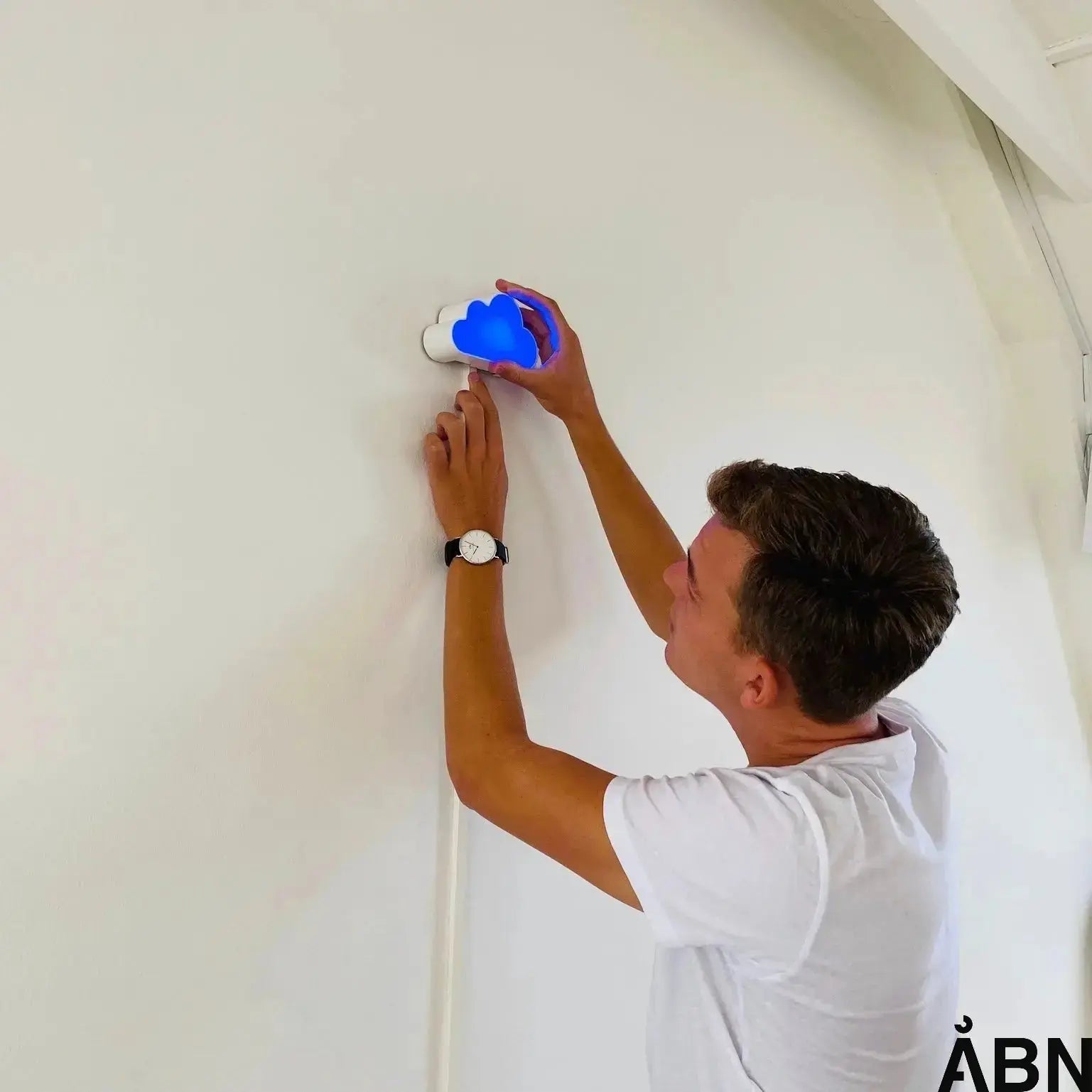A good indoor climate in schools and daycare centers is crucial for the health and well-being of employees. Research indicates that factors such as CO₂ levels , temperature , humidity , volatile organic compounds (VOCs) , noise and light can affect how often employees get sick. This report reviews recognized studies and data for each of the six parameters with the aim of uncovering a possible connection between measured indoor climate and reduced sick leave among municipal employees (e.g. teachers and educators). It also presents conclusions on the effect of implementing improvements/monitoring as well as considerations on costs and return on investment (ROI).
CO₂ (Ventilation)

CO₂ levels are often used as an indicator of ventilation. High CO₂ concentrations indicate insufficient air exchange, which can lead to the accumulation of aerosolized viruses and general fatigue. A large number of studies document a clear correlation between good ventilation and lower sick leave:
- Airborne infections and sick leave: Over half of teachers' sick leave is due to airborne illnesses (colds, flu, etc.), which emphasizes the importance of ventilation. During the COVID-19 pandemic, an Italian study of 10,000 classrooms showed that effective ventilation could reduce the risk of infection with airborne viruses by 80% ( Indoor climate with less risk of infection ). NFA research after corona generally confirms that better air quality significantly reduces the spread of infection indoors ( We can reduce sick leave: Cleaner air kills diseases | BUPL )
- Controlled studies in offices: A review of several studies shows that doubling the ventilation rate can reduce sick leave by approximately 10% . A US study of 705 office workers specifically found that when ventilation was increased from 12 to 24 L/s per person (CO₂ fell correspondingly), short-term absence fell from 2.0 to 1.45 and total sick leave from 3.9% to 3.4% ( Facts about indoor climate and productivity ). This corresponds to a ~13% relative reduction in absence with better ventilation. Similarly, the World Green Building Council reports that well-ventilated offices have up to 35% less sick leave compared to poorly ventilated ones ( Case study: NABERS high achievers clear the air | NABERS ).
- Schools and daycare centers: A Nordic study found that teachers in schools with mechanical ventilation and high air exchange had less short-term sick leave than teachers in schools with poor ventilation. For children in daycare centers , 7% fewer sick days have been shown for every 100 ppm CO₂ reduction (within the normal range) in institutions with good mechanical ventilation ( Facts about indoor climate and productivity ). In other words: even moderate improvements in CO₂ levels can be measured in terms of lower absenteeism among both staff and children.
Effect of implementation: Implementation of CO₂ meters and better ventilation has shown positive results in practice. In a Danish day care center (Børnehuset Møllehuset, Gladsaxe), the installation of mechanical ventilation led to noticeably better air quality, which staff could clearly notice: An employee with an immunodeficiency previously had pneumonia several times a year – “now it is rare for her to go to bed sick” ( We can reduce sick leave: Cleaner air kills diseases | BUPL ). Colleagues also reported fewer headaches; for example, a teacher experienced a significant decrease in migraine attacks after improved ventilation ( We can reduce sick leave: Cleaner air kills diseases | BUPL ). Overall, the research shows that the CO₂ level (ventilation) is one of the most important factors – better ventilation results in fewer infections and lower sick leave.
Temperature

Thermal comfort affects both well-being and potential immune function. Extreme or fluctuating temperatures can stress the body (too cold an environment can weaken mucous membranes, too hot can cause dehydration and discomfort). Studies indicate:
-
Optimal temperature range: Work performance is best at a neutral to slightly cool temperature, typically around 21-22°C . Performance declines if the temperature deviates from this optimum – each degree above 22°C results in about a 0.43% decrease in performance ( Facts about indoor climate and productivity ). Although this figure relates to productivity, it suggests that thermal stress gradually affects health and efficiency.
-
Extreme heat and cold: High summer heat can increase sick leave, especially without air conditioning. A Finnish study of summer days found that sick leave generally decreased with moderate temperature increases (presumably due to fewer viruses in the summer months), but when the daily mean temperature exceeded approximately 24°C , the risk of sick leave began to increase again ( Association of summertime daily mean temperature and sick leaves among employees of the City of Helsinki, Finland. | Environmental Health Perspectives ). This suggests that there is a heat threshold where the strain on the body leads to more sick days. Similarly, working conditions that are too cold (below comfort level) can cause more colds and discomfort, although direct studies of this are scarce.
- Temperature control: The ability to adjust the temperature locally can improve both comfort and health. According to a Smithsonian report, offices where employees could regulate the temperature around them experienced 30% lower sick leave compared to places without this option ( Solving The Office Temperature Problem - ChargeSpot ). Increased individualized comfort therefore reduces the stress factors that can lead to illness or discomfort.
Overall, the evidence suggests that temperatures in the “thermal comfort window” are optimal. Both too high and too low temperatures can indirectly contribute to increased sick leave through discomfort, stress or more infections. It is therefore important to keep classrooms and living rooms at a comfortable temperature (typically ~20-22°C) and to give users influence on temperature control where possible.
Humidity
 Relative humidity (RH) affects the respiratory defense mechanisms and the survival of virus particles. Dry air (low RH) dries out mucous membranes and can increase the risk of respiratory infections, while high humidity can promote mold growth. Research generally recommends a moderate humidity level and shows a clear effect on sick leave:
Relative humidity (RH) affects the respiratory defense mechanisms and the survival of virus particles. Dry air (low RH) dries out mucous membranes and can increase the risk of respiratory infections, while high humidity can promote mold growth. Research generally recommends a moderate humidity level and shows a clear effect on sick leave:
-
Recommended range 40–60% RH: Experts – including researchers from NFA – point out that the indoor climate is most healthy at approximately 40-60% relative humidity . Outside this range, health is compromised: At <40% RH, the throat, eyes and respiratory tract dry out (causing coughing, irritation, eye inflammation), which can worsen work productivity and potentially increase sick leave ( Controlled humidity reduces sick leave and the risk of spreading infection - HVACFOKUS ). Conversely, too high humidity can cause condensation and mold, which also leads to illness.
-
Study in hospitals (Canada): A classic three-year study in Canadian hospitals compared winter periods with and without humidification. In the hospital that raised the humidity (to a still moderate ~31–34% RH), the average absenteeism fell significantly: the normally expected sickness absence of ~2–3% was reduced by 0.5–1 percentage point , corresponding to a relative decrease of about 20–30%. In concrete figures, absenteeism in the humidified hospital fell from about 2.5% to 1.56% in the winter where the difference was greatest. This improvement came even though the humidity was only barely 35% RH, just below the ideal minimum. The decrease in sickness absence was primarily attributed to fewer respiratory infections in the less dry air (about 60% of the absence in the hospitals was related to respiratory diseases) ( Winter humidities and related absenteeism in Canadian hospitals ).
- Spread of viruses: Recent laboratory and model studies show that influenza viruses and other respiratory viruses thrive less well in moderate humidity (around 50%) than in dry air. Controlled humidification can reduce transmission via aerosols, which has been highlighted as a means of reducing sick leave during the winter months ( Controlled humidity reduces sick leave and the risk of spreading infection - HVACFOKUS )
These findings support the idea that humidity is an important, but often overlooked, factor. By keeping humidity levels within the recommended range (neither muggy nor damp), institutions can potentially reduce the number of sick days. Especially during the winter months, when heating dries out the air, the use of humidifiers or better ventilation control can have a measurable positive effect on health and absenteeism ( Winter humidities and related absenteeism in Canadian hospitals ).
VOC (Volatile Organic Compounds)

VOC covers chemical fumes from e.g. paint, glue, furniture, cleaning products and electronics. Indoor VOC levels are often several times higher than outdoors and can cause irritative symptoms (headache, mucous membrane irritation, etc.) at high concentrations ( Volatile Organic Compounds (VOCs) in Indoor Air May Reduce Employee Pr ). Long-term exposure to VOCs can trigger sick building syndrome (SBS) and thereby affect sick leave. Key facts and data:
-
SBS and indoor climate: As early as 1990, a Swedish 4-year study in six schools showed that chronic SBS symptoms in staff were associated with high VOC levels and certain materials. Schools with, for example, wall-to-wall carpets (which emit VOCs) and recent construction had more persistent symptoms among staff. The study found that when some of these VOC sources were removed (removal of carpets) and the most sensitive people were given a change in working environment or moved to older buildings, the SBS symptom level decreased – accompanied by fewer sick days due to respiratory disorders among staff. This indicates that high VOC exposures can contribute to sick leave, particularly via irritation of the respiratory tract. ( Volatile organic compounds, respirable dust, and personal factors related to prevalence and incidence of sick building syndrome in primary schools - PubMed )
-
Acute effects of VOC: In the short term, VOC can cause discomfort that potentially causes employees to go home sick (e.g. strong paint odors or solvents that cause dizziness). A statement from OSHA (the US Occupational Safety and Health Administration) estimates that poor indoor air quality, including chemical contaminants, costs companies large amounts of money annually in sick leave and reduced productivity (estimated at 15 billion USD nationwide) ( Air Quality At Work and In The Office - Rabbit Air ). Although this figure covers many factors, it emphasizes the role of VOCs as part of the indoor air quality problem.
- Prevention and measurement: There are fewer quantitative studies directly on VOCs and sick leave than for example CO₂. Nevertheless, the EPA and other authorities recommend limiting VOCs in the indoor environment as “poor indoor air quality” leads to symptoms that ultimately increase absenteeism. Monitoring VOC levels can reveal hidden sources (e.g. cleaning chemicals or insufficient ventilation after newly purchased furniture) and provide a basis for measures that improve air quality and reduce illness. ( Volatile Organic Compounds (VOCs) in Indoor Air May Reduce Employee Per )
In short: VOC pollution contributes to an unhealthy indoor climate, which in the long run can increase sick leave through irritative symptoms and poorer health among staff. Efforts for low-emitting materials, good ventilation and possibly sensors for VOC can help keep levels down and staff healthier.
Noise

Noise and poor acoustics are not classic “air quality parameters”, but they are part of the indoor climate as an acoustic environment . Persistent noise at work can lead to stress, fatigue, difficulty concentrating and in some cases physical health problems (e.g. high blood pressure). These factors can indirectly increase the risk of sick leave. Research in this area shows:
-
Noise exposure and long-term sickness absence: A prospective study from the National Research Center for the Working Environment (NFA) followed 5,357 Danish employees and found a significant correlation between perceived noise exposure at work and the risk of long-term sickness absence (>2 weeks duration). The effect was particularly clear among men: men who reported being exposed to high noise levels one quarter to three quarters of their working time had a 43% increased risk of long-term sickness absence compared to men without noise exposure. Even “little/rare” noise gave a 37% increased risk. (For women, a noise-absence correlation was also seen, although it partially decreased when corrected for physical workload. Overall, the study concludes that there is evidence that occupational noise increases the likelihood of sickness absence ( Self-reported noise exposure as a risk factor for long-term sickness absence - PubMed ).
-
Well-being in schools: Noise also has an impact on teaching environments. A Danish study (NFA, 2011) showed that primary school teachers thrive better in rooms with good acoustics ( Facts about indoor climate and productivity ). Poor acoustics/noise, on the other hand, led to more complaints about fatigue and stress. Even if this is not directly measured as sick days, reduced well-being can lead to increased short-term absence (e.g. headache-related sick days) and, in the long term, burnout. In addition, high background noise can exacerbate other stresses; a report notes that frustrations and conflicts are amplified if you are already under pressure and are also plagued by a poor (noisy) indoor climate ( Industry guidance for indoor climate in schools )
. - Prevention: Unlike the other parameters, noise levels can vary greatly depending on behavior and interior design. For example, employees in daycare centers are exposed to many impulses from children. Measures such as soundproof ceilings, screens and good planning of noisy activities can reduce the overall noise load. In office environments, it has been seen that disconnecting from constant noise can improve the health of employees. (New research even suggests that both too much and too little background noise can be inappropriate – a moderate noise level of around 50 dB was associated with the best well-being in a study ( Key to healthier employees could be a quieter – or louder – office ... ). This emphasizes the need for a balanced sound environment).
Overall, noise is a work environment factor that affects health and sick leave indirectly through stress and well-being. The authorities' guidelines also recommend ensuring good acoustics in schools and institutions. Although air quality meters typically do not include noise, separate noise measurements or acoustic evaluations can be part of an overall effort to reduce sick leave.
Brightness (Lighting)
Lighting conditions – especially access to daylight – have a major impact on people’s circadian rhythms, mood and eye strain. Insufficient or incorrect lighting can cause headaches, eye strain and disrupted sleep patterns, all of which can lead to more sick days. On the other hand, good lighting (natural light or quality artificial light) can improve health. Some key findings:
-
Daylight and sick leave: A 2011 study from the University of Oregon linked views and daylight to employee sick days. Employees with good window views and ample daylight took 6.5% fewer sick days than their counterparts without these lighting conditions ( Benefits of Natural Light in the Workplace | Blog | New Day ). The difference is attributed to better mood and health as a result of more natural light. The World Green Building Council also notes that employees with access to ample natural light sleep better (almost 46 extra minutes per night on average) and have higher overall well-being ( Case study: NABERS high achievers clear the air | NABERS ). Better sleep strengthens the immune system, which in turn can reduce illness.
-
Symptoms and discomforts of poor lighting: A field study from Cornell University found that employees in offices with plenty of daylight experienced 84% fewer eye and head problems (e.g., headaches, eye strain) than employees in offices without natural light ( Benefits of Natural Light in the Workplace | Blog | New Day ). These symptoms – when present – can lead to sick leave (migraine attacks, vision-related discomfort). Poor lighting, especially flickering fluorescent lights or constant low light, can also affect mental health and potentially contribute to absenteeism (e.g., winter depression in dark environments).
- Implementation and recommendations: Architectural studies indicate that maximizing the use of daylight in buildings pays off. A notable experiment at a retail company (Walmart stores) showed 40% higher sales in departments with skylights compared to those without ( Benefits of Natural Light in the Workplace | Blog | New Day ) – an indirect measure of how much people thrive and perform better with natural light. For schools and daycare centers, the recommendation is to ensure daylight in the premises combined with good artificial lighting that can be adjusted (dimmed/boosted) as needed. Light sensors can monitor brightness and help keep levels within a comfortable range, which can prevent light-related discomfort.
In summary, the evidence suggests that light has some documented effect on sickness absence: more natural light and comfortable lighting results in healthier and happier employees who are less likely to call in sick ( Benefits of Natural Light in the Workplace | Blog | New Day ). Conversely, poor lighting conditions can contribute to increased absence through negative effects on sleep and well-being.
Implementing air quality meters: Impact, costs and ROI
The use of indoor climate sensors (CO₂ meters, thermometers, hygrometers, VOC detectors, etc.) makes it possible to continuously monitor environmental parameters and react before they affect health. Implementing such meters in municipal institutions can have several concrete effects:
-
Proactive improvement of indoor climate: Real-time monitoring makes it easier to keep CO₂, temperature, humidity, etc. within recommended limits. Experts highlight a strategy called “Monitor, Analyze, Manage” , where data can be used to adjust ventilation, heating, etc. in time ( Case study: NABERS high achievers clear the air | NABERS ). For example, real estate projects have shown that connecting sensors to building management both improves air quality and provides side benefits such as energy savings ( How monitoring indoor air quality saves energy & other business costs ). In Australia during the bushfire smoke in 2020, office buildings were kept healthy by constantly monitoring particles and adjusting the air intake – the result was that the air inside became better than in people's private homes. This illustrates that measurement is the key to quickly ensuring a healthy environment and thus avoiding cases of illness.
( Case study: NABERS high achievers clear the air | NABERS )
-
Documented effects of measures: As reviewed above, the implementation of specific improvements (better ventilation, humidification, acoustics, lighting) shows clear reductions in sick leave: 10–30% fewer sick days is not unrealistic depending on the baseline. For example, in one case, ventilation improvements resulted in 27% less short-term absence ( Facts about indoor climate and productivity ), and humidification resulted in ~25% less winter absence ( Winter humidities and related absenteeism in Canadian hospitals ). Being able to measure the parameters is crucial to achieving these results consistently, as otherwise you do not know when the indoor climate deviates. At the same time, monitoring creates awareness among employees and management – which in itself can lead to better habits (e.g. more ventilation during breaks when the CO₂ meter is red).
-
Costs vs. benefits: The price of modern indoor air quality meters is relatively low compared to the benefits. A typical IoT-based CO₂/climate meter may cost a few thousand kroner per room, and the operating costs are limited. The benefits of a better indoor climate, on the other hand, are shown in reduced sick leave and increased productivity, which has great economic value. Sick leave is expensive – a single sick day for a teacher or educator costs not only in salary, but also in temporary staff costs and potentially poorer service. Calculations from an international meta-analysis estimate that good indoor air conditions can save a company around $400 per employee per year in reduced sick leave ( The ROI of Indoor Air Quality: How Your Air Affects Your Bottom Line | ScentAir ). For schools, Denmark has made socio-economic models: In a hypothetical example with 50 teachers and 650 students, a better indoor climate could provide societal benefits equivalent to up to 1.16 million kroner saved in teacher salaries due to fewer sick days over 30 years ( Industry Guide to Indoor Air Quality in Schools ) (and DKK 11–22 million in increased lifetime earnings due to improved student attendance and learning). Even if these figures are long-term, they illustrate a high ROI. A recent report from the World Green Building Council (2018) even found that a healthier workplace could reduce sick leave by up to 58% ( How monitoring indoor air quality saves energy & other business costs ) – a drastic decrease that would mean enormous savings in practice.
-
ROI and payback period: When calculating the investment in indoor climate, it often turns out that it is quickly earned. As the Danish Technological Institute concludes in an industry guide: “When future gains from increased learning and less sick leave are included, it is quite simply economically beneficial to provide schools with a good indoor climate.” ( Industry guide for indoor climate in schools ). That is, even though it costs money to install, for example, ventilation systems, sensors or acoustic ceilings, the value of better student performance and fewer sick days clearly exceeds the costs. For municipalities, lower sick leave means, among other things, fewer temporary payments and less pressure on remaining staff.
- Indirect benefits: In addition to fewer sick days, a well-monitored indoor climate can lead to higher satisfaction and retention among employees. Staff feel valued when the working environment is prioritized (The message “our employer provides healthy air, appropriate sound and light” increases morale) ( Case study: NABERS high achievers clear the air | NABERS ). This can lead to less employee turnover and thus additional financial benefits that cannot be directly measured in the sick leave account, but still contribute to ROI.
In summary : Investing in air quality meters and indoor climate improvements pays off. The possible reductions in sick leave (typically 10-30% and in some cases even higher) provide significant savings that can quickly exceed the costs. Monitoring is the first step – it makes it possible to target efforts, document improvements and continuously ensure an optimal environment for employees and children.
Overall summary of evidence
There is a large and growing body of evidence that a healthy indoor climate with controlled levels of CO₂, temperature, humidity, VOCs, low noise and good lighting is associated with lower sickness absence among employees in schools and daycare centers. Ventilation/CO₂ and air quality in general stand out as critical factors, with both experimental studies and practical examples showing fewer cases of illness when the air is fresh ( Facts about indoor climate and productivity ). Temperature, humidity, light and noise have a more indirect effect via comfort and stress, but even here there is documentation of concrete effects – e.g. fewer sick days with comfortable temperature control ( Solving The Office Temperature Problem - ChargeSpot ), moderate humidity ( Winter humidities and related absenteeism in Canadian hospitals ) and good access to daylight ( Benefits of Natural Light in the Workplace | Blog | New Day ), as well as increased absence from persistent noise exposure ( Self-reported noise exposure as a risk factor for long-term sickness absence - PubMed ).
Critically, implementation makes the difference: setting up sensors and following up with improvements yields measured results. Without action, a measurement is just a number. Fortunately, both the research literature and case studies indicate that even fairly simple measures can yield significant improvements in the indoor climate and thus fewer sick days. Overall, the evidence concludes that investments in indoor climate – supported by data from air quality meters – are beneficial for both employee health and the economy of municipalities ( Industry Guide for Indoor Air Quality in Schools ) ( The ROI of Indoor Air Quality: How Your Air Affects Your Bottom Line | ScentAir ). A good indoor climate is thus not just “nice to have”, but a strategic key to reducing sick leave and ensuring a productive, well-functioning learning and working environment.









